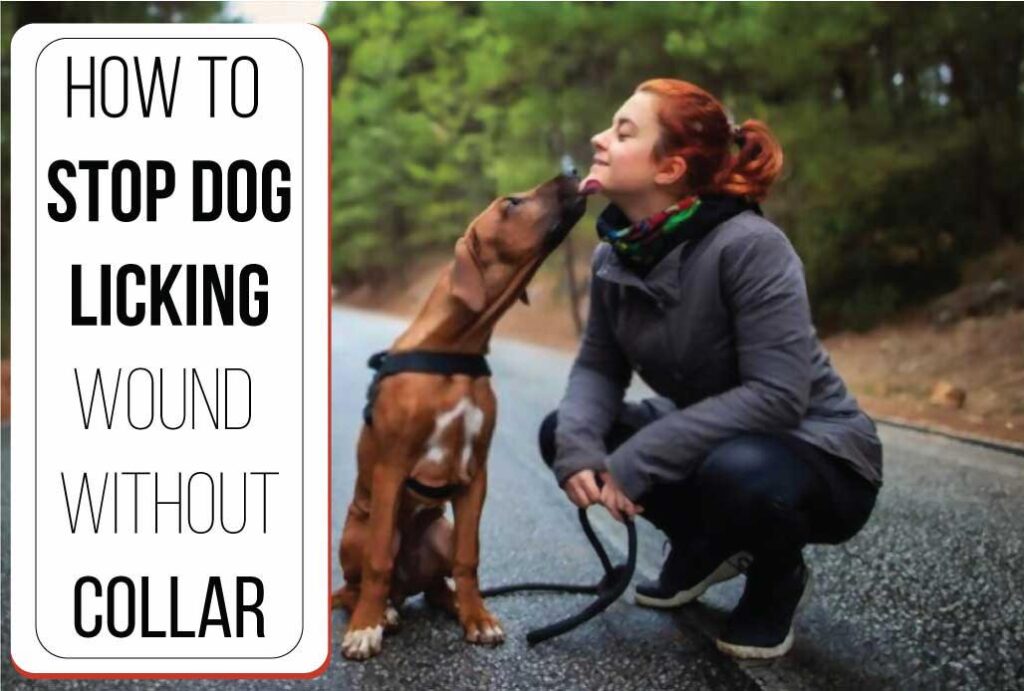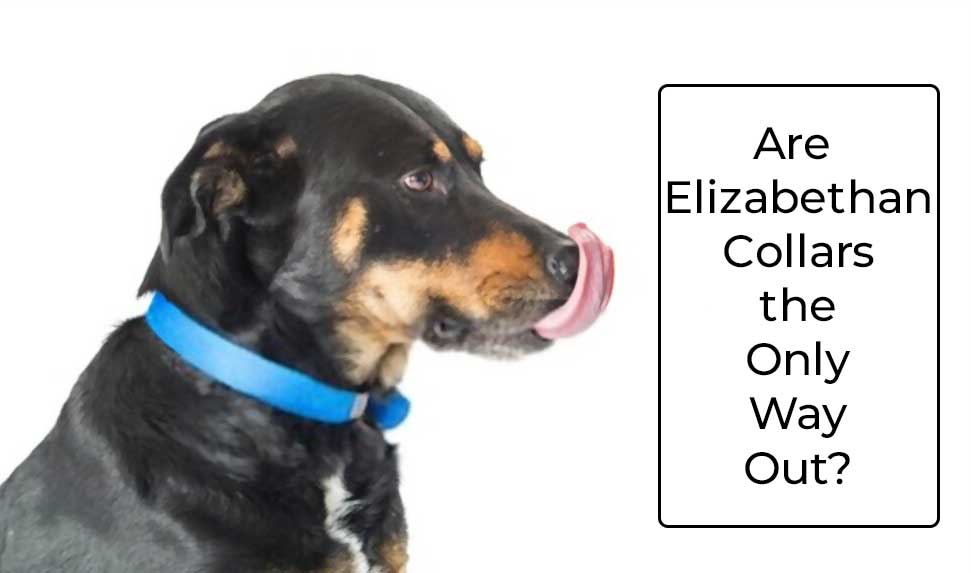Why buddy? Why? Don’t you understand your good? I used to ask him repeatedly when he got wound from a sports event last year.
Licking his wound was his favorite pastime. Back then, I applied several methods to keep him safe from infection. There was an easy option for me: apply a collar. Instead, I searched for more sustainable ways on how to stop dog licking wounds without a collar. Amazing facts came up, and I used them successfully.

Today, I will share with you a part of my research on this. So, Let’s gain complete authority over dog parenting!
But, before going to the in-depth analysis, I can summarize the whole thing for you. You will need a dog collar to stop a dog from licking a wound. In that case, you can read the following in-depth review articles on dog collars, these will help the dog wound to heal.
- Review of Elizabethan Dog Collar Alternatives, here.
- Typical Medical Dog Collar Alternative (Best for healing dog wound), here.
- Prong Collar Alternatives Review, here.
Why Do Dogs Lick and Chew on Wounds?
According to Animal behaviorist Dr. Jill Goldman, “Dogs lick wounds, it’s their natural instinct. The salivary gland of both human and dogs contain few antibacterial biochemicals, but licking is rather harmful to animals“.
Dr. Goldman briefly trailered the whole picture for us. The biological perspective of the dog’s wound licking phenomena is quite similar to human pain response. Wounded spot sends neurological signals to the dog’s brain and in response to that signal brain act fast to heal. The option remains to the poor dogs is to lick the wound, expecting rapid healing. Agonized neurotransmitters instantly stabilize, and pain signal cascade stops temporarily. But, when salivary bacterial populations react adversely with wounded tissue mass and trigger excessive inflammation, dogs lose control and chew wounded areas aggressively and excessively.

Why You Should Not Let Your Dog Lick an Open Wound
Wound healing by saliva is a method of the stone age. When it comes to dogs, wound licking is dangerous. But, Hey, Wait! Don’t decide too early. Let’s delve deeper together on biological aspects, whether we should let our dog lick wound or not. First, we have to understand the difference between “Cut” and “Wound.“
- Cut: A cut or scrapes is minor injuries, specifically affects skin tissues, may bleed a bit, and drain out some fluid.
- Wound: A severe injury that affects skin tissues, muscle tissues, and sometimes internal organs.
Why is it important to know the difference between cut and wound?
If your dog got a small cut, then a little lick will help the injury to heal, but in case of a wound, there is no way you should let your dog chew on an open wound. There is a big NO to lick if your dog is recovering from a surgery or have a stitch.
Now, you might wonder how to stop a dog from licking a wound after neutering? Yes, you might use an Elizabethan Collar or other types of collars. Next section, you will find more alternatives to the Elizabethan collar. Also, at the end of the script, I will share my trick.
There are several hazards related to lick a wound, such as excessive irritation, severe infection, and self-mutilation. Dog licking wound raw spots can lead to painful, recurrent traumatic events.
There may be a debate on some beneficial bacteria of saliva, such as Lactoferrin, which kills pathogenic bacteria by disintegrating their cell wall but, you have to keep in mind, dogs are not well aware of their nurturing, we are.
I know what you are thinking now! We should look for a home remedy to stop dog from licking wounds, right? That’s the way a cynophile should think.

Are Elizabethan Collars the Only Way Out?
Commonly, Elizabethan Collars or E-Collars are used to keep dogs away from wound licking. Elizabethan collars are a good option but not the only way out. A correctly sized E-collar can stop dogs from licking wounds.
You might think, does this collar effect dog’s natural activities like eating, sleeping or peeing? No, if you choose a perfect collar/ Bark Collar, made of comforting materials, then surely it will not hinder the comfort level of your log.
But there might be some issues other than bigger comforting, such as, if you have a dog home and your dog might wonder why he/she can’t come out quickly through doors these days. Some dogs are allergic to plastic materials used in Elizabethan collar.
A recent study published in “Animals (Basel)” February 2020 by a group of scientists showed that 77.4% (Total Participants 434) animals faced challenges mentally and physically during the Elizabethan collar was worn. It also hampered a wide range of animal welfare domains such as behaviour, nutrition, environment, and health. (Shenoda et al., 2020)
There are other options available if you don’t like Elizabethan collar or think it is rude for your buddy.
- BITENOT: This collar is suitable for mobility and typically fits like a neck brace.
- PROCOLLAR: Very light weighted collar, washable, and fits like a neck pillow. Often, interferes with audio-visual activity, but a good alternative to try.
- KONG EZ SOFT: It’s a cone-shaped collar. I would say it’s an ‘Alien version’ of Elizabeth collar. It has a negative effect on mobility, comfort, and audio-visual activities.
- COMFY: Although comfy collars effects audio-visual activities, but it is excellent for more effortless mobility, stay on capacity, and comfort level.
- BOOBOOLOON: This collar can be called a next-gen dog friendly collar. Obviously, worth a try. Great for comfort, audio-visual activities, mobility, and stay on for a long period.
- OPTIVISOR: It fits like a face mask. Excellent alternative of Elizabethan collar. No adverse effect on a dog’s daily life has been reported yet.
- TCOA SOFT E-FABRIC: Its cone-shaped couple knots tied together. TCOA SOFT E-FABRIC hinders audio-visual activity of dogs. It is easy for dogs to get rid of this collar quickly.
Why Is My Dog Throwing Up Undigested Food Hours After Eating?
Additional gears for dogs can lead them to vomit after hours of eating. Sadly, most of us miss the relationship between these two factors: ‘Collars’ & ‘Vomiting.’ Blockage in the neck region can hamper the proper chewing of food, thus leads to lumps of food in the stomach. Not every collar is the culprit of doing this to your dog. It may be a cause of misplacement of the collar during playtime or sleeping.
Trick No One Going to Share:
Collars are still good and permanent options to stop dogs from licking, but I will share a DIY home remedy to prevent dogs from licking wound. Give your dog a cloth to wear. You can cut and sew an old T-shirt of yours to the size of the dog. A jacket or casual dog shirt will resist the dog from licking the wound.
Frequently Asked Questions:
Q1#. Why are shock collars bad for dogs?
Answer: Shock collars can lead to physical damages to dogs. Most importantly, it can adversely affect the mental health of dogs. Physical injuries are visible and immediate actions can be taken to soothe but, mental damages are irrevocable and can drive dogs to become aggressive.
Q2#. When should you use a shock collar?
Answer: These are often used to get rid of unwanted behaviours like excessive barking, scratching up the furniture, food aggression and restlessness.
Q3#. How do you train a dog with a shock collar?
Answer: Shock collars are often used to train dogs. Ages ago, shock collars were unsafe for dogs, but now, shock collars are more sensitive and well simulated. To be exact, training a dog with a shock collar is like a seat belt alert system in your car. We get in the car, push the ignition, start driving without a seatbelt, and beeper continuously buzzing around until it gives you a bad headache or forced you to buckle up the belt. So, we get trained to buckle up to avoid its painful noise. Shock collars do the same for dogs.
Q4#. Are police dogs trained with shock collars?
Answer: It’s a common practice to train police dogs with shock collars. Training methods are well established and harm free. Shocks provided to the dogs are within the tolerance limit of dogs.
Final Words:
From one cynophile to another, Undoubtedly, dogs are our best companions, and we should know what’s best for them. We always seek a better option to get rid of any unwanted situation. Sometimes, we fail to find doable advice to get a permanent remedy. This article will help you to understand and make a decision on how to stops dogs from licking wounds.
References:
Shenoda Y, Ward MP, McKeegan D, Fawcett A. “The Cone of Shame”: Welfare Implications of Elizabethan Collar Use on Dogs and Cats as Reported by their Owners. Animals (Basel). 2020;10(2):333. Published 2020 Feb 20. doi:10.3390/ani10020333

This is Evelin K. Williams. I am passionate about dogs, cats, and love sharing everything. I have Created dog cat talk to talk about my journey. Products that I have used/admire, and lessons that I have learned in my dog cat career.
